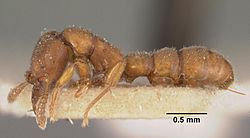Amblyopone saundersi facts for kids
Quick facts for kids Amblyopone saundersi |
|
|---|---|
 |
|
| Scientific classification | |
| Kingdom: | |
| Phylum: | |
| Class: | |
| Order: | |
| Family: | |
| Subfamily: |
Ponerinae
|
| Tribe: |
Amblyoponini
|
| Genus: |
Amblyopone
|
| Species: |
A. zelandiae
|
| Binomial name | |
| Amblyopone saundersi Forel, 1892
|
|
Amblyopone saundersi is a special type of ant found only in New Zealand. It belongs to a group of ants called Amblyoponinae. This ant was first described in 1892 by a scientist named Auguste-Henri Forel.
Contents
Discover Amblyopone saundersi
What is This Ant?
Amblyopone saundersi is a small insect that lives in colonies. Like all ants, it has six legs and a body divided into three main parts: the head, thorax, and abdomen. These ants are often dark in color. They are also known for their strong jaws, which they use for hunting.
Where Does It Live?
This ant is endemic to New Zealand. This means it is found naturally nowhere else in the world. It lives in the forests and natural areas of New Zealand. Ants play an important role in these ecosystems. They help to keep the soil healthy.
What Do They Eat?
Amblyopone saundersi ants are predators. They mostly eat other small insects and arthropods. They are known for a unique feeding habit called "hemolymph feeding." This means they sometimes feed on the body fluids of their own larvae. The larvae are the young ants. This helps the adult ants get nutrients.
Ant Colonies: A Closer Look
Life in an Ant Colony
Ants like Amblyopone saundersi live in organized groups called colonies. A colony can have thousands of ants. Each ant has a specific job.
- The queen ant is usually the largest ant. Her main job is to lay eggs.
- Worker ants are female ants that do not reproduce. They do most of the work. This includes finding food, building the nest, and taking care of the young.
- Male ants have one job: to mate with the queen. They usually die soon after mating.
Ants communicate using chemicals called pheromones. These chemicals help them tell each other where to find food or if there is danger.
The Ant Life Cycle
Ants go through a process called complete metamorphosis. This means they change a lot as they grow. The life cycle has four stages:
- Egg: The queen lays tiny eggs.
- Larva: The eggs hatch into larvae. These look like small, white grubs. They mostly eat and grow.
- Pupa: The larva changes into a pupa. This is a resting stage. During this time, the ant transforms into its adult shape.
- Adult: The adult ant emerges from the pupa. It is now ready to do its job in the colony.
Why Ants Matter
Ants are very important for the environment. They help in many ways:
- Soil health: As ants dig tunnels, they mix the soil. This helps air and water get into the ground.
- Seed dispersal: Some ants collect seeds. They might drop them along the way, helping plants spread.
- Pest control: Many ants eat other insects. This helps control populations of pests.
- Food source: Ants are also a food source for other animals. These include birds, lizards, and other insects.
Amblyopone saundersi is a small but important part of New Zealand's unique wildlife. Studying these ants helps us understand more about nature.
See also
 In Spanish: Fulakora saundersi para niños
In Spanish: Fulakora saundersi para niños

